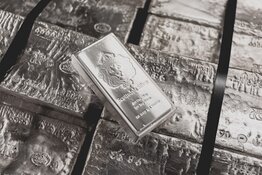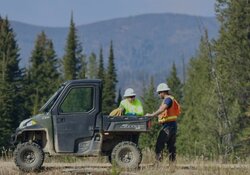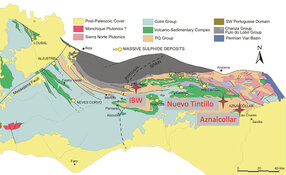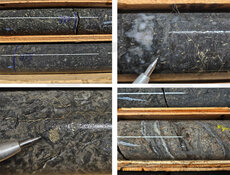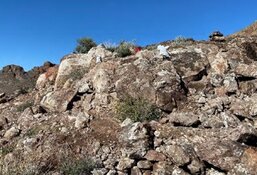The Critical Metals Report: On Aug. 2, Molycorp Inc. (MCP:NYSE) posted a loss of $0.03/share. Given that Molycorp is the rare earth element (REE) flagship story, what impact will this have on the broader space?
Chris Berry: The earnings miss was definitely a shock and the market took the shares down accordingly. It appears that Molycorp fell victim to a phenomenon that we are seeing across the spectrum of natural resource companies: higher costs and falling or stagnant metals prices. This compresses margins, which affects profitability and destroys shareholder value. The company also shipped less product than it anticipated and will have to raise more capital, which were two more big surprises.
"Companies with economic HREE deposits in reliable geopolitical jurisdictions still deserve a premium, and this is where the opportunity lies."
Markets these days are particularly unforgiving, and raising additional capital on favorable terms is difficult at best. I have ratcheted down my expectations for outsized returns in mining shares until we get a clearer picture of global growth and industrial demand. For the last 10 years the commodity super cycle has been in full force, driven mainly by countries in the emerging world like China and India. And while I believe the super cycle is still alive and well despite slower economic growth, it is a long-term phenomenon. I agree with the theory that metals prices will be permanently higher as billions of global citizens urbanize and enhance their lifestyles. However, I disagree with the theory that metals prices will continue to increase permanently. The cyclicality of mining shares validates this.
TCMR: In a recent edition of Morning Notes, you note that many of the market leaders in the REEs space are "stuck in neutral" and reaffirm that China remains in control of the REE value chain. How could that affect smaller REEs players?
CB: I think this actually presents an opportunity. In that same Morning Notes edition, we profiled 20 REE companies and showed their year-to-date (YTD) returns and cash balances. Their returns were not pretty; the average return was about -30%, but many of the companies have surprisingly ample cash balances. This is a positive sign, as financial sustainability is crucial. These companies need to manage their cash prudently and aim for specific goals in a market where good news is often ignored and bad news is severely punished.
Meanwhile, China is moving to consolidate its industry supply chain and continue its market dominance. Lackluster demand for REEs should buy time to accomplish this as Western dependence on REEs and other critical metals fades from the front pages of the newspaper in favor of economic headwinds, the U.S. Presidential election or any number of other topics.
Companies with economic Heavy Rare Earth Element (HREE) deposits in reliable geopolitical jurisdictions still deserve a premium, and this is where I think the opportunity lies. They will attract renewed interest based on demand from the emerging world.
TCMR: If China still controls the value chain, does that give smaller players a better chance at share price appreciation, given that the bigger players have not done much to move the needle?
"We still believe that fundamentals matter the most."
CB: No, not necessarily. Smaller players have a better chance at share price appreciation by demonstrating solid economics at their deposits and striking accretive deals with end users. There are enormous metallurgical and financial complexities involved in bringing an REE operation from exploration and development to production and integration into the supply chain. Share price appreciation can occur if these challenges are met with success. Recently, we've seen the two leaders in the space stumble. Molycorp will go back to the capital markets to fund its buildout at Mountain Pass. Lynas Corp. (LYC:ASX) is having difficulty finding a location to store the tailings from its Mount Weld deposit. Right now investors are trying to figure out who has the best opportunity to get into third place.
We still believe that the fundamentals matter the most. Well-managed companies with ample cash to get through today's uncertain markets, whose REE deposits are in reliable geopolitical jurisdictions are the candidates most likely to create value and integrate into a global REE supply chain in the future.
TCMR: And those with low-cost operations.
CB: Right. We believe that the lowest-cost producer always wins across just about any industry. That is one of the reasons China dominates the market.
TCMR: But if cost escalation is happening so fast, how can we be certain that the low-cost producers will remain low-cost producers?
CB: You cannot. The macroeconomic picture and the industrial demand picture are very uncertain right now for all metals. We have seen cost inflation in feasibility studies across the lithium, graphite and manganese sectors and in the earnings reports of major gold producers as well. This tells me that cost inflation is endemic and no metal or mineral is really immune. It also goes back to why I think a "reset" of expectations for share returns is prudent.
Because of this phenomenon, management capability and financial soundness are the two most important factors we look at when evaluating a junior.
TCMR: Will China eventually become a net importer of REEs?
"Cost inflation is endemic and no metal or mineral is immune. This is why I think a 'reset' of expectations for share returns is prudent."
CB: A lot of that depends on its growth trajectory. I have seen pronouncements made that China will be a net importer of REEs within the next few years, but this is a fragmented market and nobody can know for sure if the data coming out of China, be it growth rates or production numbers for metals, is entirely accurate. I do think the country is on a course to become a net importer and I say this by looking at the amount of research and development (R&D) going on in the REE space in China.
In its 12th five-year plan, China committed to spending roughly US$630 billion (B) on developing intellectual property and next-generation technologies. What the Chinese call "the seven pillars" form the foundation of its intellectual property development strategy. All of the pillars relate to industrial minerals like graphite, rare metals or lithium.
Trying to forecast supply and demand in the REE space is difficult when you consider the enormous sums going into R&D and intellectual property development. Perhaps a group of scientists will achieve a breakthrough in battery technology that offers dramatic performance enhancements and requires no REEs. If the technology can be commercialized, this would obviously shift the supply and demand projections significantly. I realize it may be a stretch to think this way, but with the pace of change in materials science today, the possibility certainly exists.
TCMR: Are the Chinese likely to do more offtake agreements or simply buy REE companies outright?
"China has very deep pockets, and it thinks 50 years out. It will continue to acquire assets."
CB: China's rise is a sensitive political issue in capitals all over the world. Whether it is offtake agreements or takeovers, this is more of political issue than a financial or economic issue. China has certainly been demonized in the Western press and is on a worldwide shopping spree for natural resources and intellectual property. It has very deep pockets, and it thinks 50 years out. China will continue to acquire assets because it has to feed a hungry and growing population striving for a better quality of life. Earlier this week the lithium-ion battery manufacturer, A123 Systems Inc. (AONE:NASDAQ), signed a non-binding Memorandum of Understanding with Wanxiang Group, a large Chinese auto parts manufacturer, to have Wanxiang make a strategic investment of up to $450 million. A123's grave financial difficulties are no secret, so Wanxiang has effectively "bought" the state-of-the-art technology A123 has developed and could end up owning 80% of A123. This is only one example of China's attempts to move up the value chain.
TCMR: You and your father created the Discovery Investing Scoreboard (DIS) to help investors determine which companies are better bets than others. Does it specify which companies are well positioned for the shifts in the REE space?
CB: I think DIS does identify which companies are well positioned in the REE space. The idea behind DIS is to crowd score a company. DIS users—and we have about 960 now—score 10 specific factors. We use word scores rather than numbers to "rank" a company: very good, good, nominal, somewhat poor or poor. This is because people think in terms of words instead of numbers. Once you have scored each factor, the system then kicks out a weighted score between 0 and 10, 10 being the best, 0 being the worst. Users can change their assumptions about a company in real-time, so if a company issues a favorable bankable feasibility study or an unexpectedly poor earnings report, you can adjust accordingly and get an idea of what the "crowd" is thinking about a name. Users can see their scores and compare it to the crowd score and track them over time.
Though the crowd sizes are still small, our initial data appear to show that the direction of the crowd score is an indicator of future share price. In other words, as the crowd score ticks up, share price has moved in the same direction over time. Conversely, as a crowd score has fallen, share price seems to fall as well. We're watching this closely.
Right now, the highest-ranked companies include Orbite Aluminae Inc. (ORT:TSX), Medallion Resources Ltd. (MDL:TSX.V; MLLOF:OTCQX; MRD:FSE), Tasman Metals Ltd. (TSM:TSX.V; TAS:NYSE.A; TASXF:OTCPK; T61:FSE) and Frontier Rare Earths Ltd. (FRO:TSX).
TCMR: But none of them is scored higher than 7. The closest is Tasman at 6.26 out of 10.
CB: It is fair to say there is no clear frontrunner, because we all have different viewpoints, opinions and biases. Of the 775 companies, I think the highest-ranked is around 7.8. Though many of the share prices of REE companies have been punished in 2012, we think that watching the trend of the crowd score can provide significant insight into how a company is "viewed" by the marketplace. As the size of the crowd continues to grow, we will be watching for more evidence of these types of relationships closely.
We find that the scores of the people who really love a company and those who really hate a company tend to get diluted. Most of the scores are between 4.5 and 6.5. It's very difficult to value a junior mining company because there typically have no revenues or cash flows to discount to get a net present value. The DIS is designed to take that subjectivity and guesswork away.
TCMR: Three of your top four have had good years. Alkane is up 8.29% YTD and Medallion is up about 38% YTD. Rare Element Resources Ltd. (RES:TSX; REE:NYSE.A) is up 21.5% YTD, but has a DIS score of only 5.8? Why so low?
CB: It is more important to look at the decile of a company. Each company has a score that places it in a given decile relative to its peers. So 5.8 isn't a terribly low score. It's important to look at the trend of the crowd score rather than just the static number. When we break down the ten factors, it appears the crowd really likes the company's asset and has this factor ranked highest, along with the capability of management. It is interesting to note that the most important factors in the eyes of the crowd for Tasman and Medallion were the potential for their assets and the capability of management—exactly the same as Rare Element Resources. This should give everyone insight into what the "crowd" is concerned with. Company management teams should find this of particular interest. With Frontier, it appears that stakeholder relations are key, and this makes sense when you look at the company's relationship with KORES.
TCMR: Let's move to the market's sour take on graphite plays. Is that specific to graphite or is it part of the larger trend?
CB: It is not specific at all. There has been a predictable pattern with share price appreciation of certain metals and minerals in recent years. Uranium went to $140/pound and collapsed. Lithium took off and then came back down to earth. Most recently, REE prices went parabolic, and have since come down. Graphite has followed the same pattern. Some people call this the "mystery history" curve when a company's share price rapidly appreciates due to investor excitement and then falls as the company matures from exploration to development to possible production. We wrote a Morning Note several months ago discussing this and basically stating the case that the mystery phase associated with graphite was over and now the companies in the space would need to begin the process to defining and developing a resource, proving economics and making the push towards production.
"The more information we know about a deposit, the better. End users want proof that a mining company can produce graphite to their very strict specifications."
Regarding graphite, investor exuberance more than anything pushed shares higher and interest in graphene must also be mentioned. In addition, global growth rates and industrial demand have been falling for months. Graphite is an industrial mineral, so as we've seen growth slow, intuitively graphite prices must soften as well. On the positive side, graphite does offer multiple avenues of demand. In addition to current-day demand from refractories and steelmaking, you have future avenues of demand like fuel cells and batteries. I think this paints an overall positive longer-term picture for graphite demand.
When analyzing a given metal or mineral, I spend just as much time researching end users as I do researching juniors. Despite the uncertainty in various economies, long-term deals involving graphite are occurring. Earlier this year, SGL Carbon and ArcelorMittal S.A. (MT:NYSE) signed a five-year deal worth several hundred million dollars for SGL Carbon to supply graphite electrodes to ArcelorMittal. This was the biggest contract in SGL's history. This is only one example, but is indicative of a strong future for graphite.
TCMR: You talk a lot about graphite companies having a balanced footprint. What does that mean?
CB: Think of the footprint as the composition of a given deposit. There are different types of graphite—flake, amorphous and vein—and flake is comprised of different sizes. Generally speaking, the supply-and-demand dynamics are different for the various types and flake sizes and they all command different prices on world markets.
When I look at a graphite project, I want to get an idea for what the actual composition is, what the percentages of large, medium and small flake are and what the carbon content is. This gives me a rough idea of the potential economics.
To be fair, many of the junior mining companies involved in graphite have not done enough drilling on or analysis of their properties to know what the footprint actually looks like. However, with the "mystery" phase of graphite behind us, it is crucial to understand this information about a deposit.
TCMR: Does the graphite space need more companies reaching the bankable feasibility stage, like Northern Graphite Corporation (NGC:TSX.V; NGPHF:OTCQX), or is it more important that companies reach agreements with end users?
CB: The more information we know about a deposit, the better. I think a graphite company would have trouble securing an agreement with an end user without a bankable feasibility study or a great deal of due diligence. Graphite is a product requiring high degrees of specificity in terms of purity. End users would naturally want proof that a mining company can produce graphite to their very strict specifications before entering an agreement. Failure to do so would interrupt and perhaps halt an end user's supply chain.
TCMR: But end-user agreements have been signed throughout the REE space with far less than bankable feasibility studies.
CB: This is because China owns the entire REE value chain from "mine to market." This is not the case with graphite. Though China controls upwards of 80% of global graphite production, there exists a viable graphite supply chain outside of China, so you don't see the same urgency with graphite that you do with REEs.
TCMR: What are the top three crowd scores in the graphite space on DIS?
CB: There are no surprises here: Flinders Resources Ltd. (FDR:TSX.V), Northern Graphite and Focus Graphite Inc. (FMS:TSX.V) are the Top 3.
With respect to Flinders, the crowd seems most impressed with its management and financial soundness. The company has $18 million (M) in the bank and is working towards bringing its 100% owned Kringel graphite mine back into production. The fact that this is an existing mine is key as the company's capital expenditures and infrastructure costs will be relatively low.
The crowd has ranked Focus Graphite's asset potential and financial soundness as its best attributes. The Lac Knife deposit is one of the highest-grade graphite deposits in the world and its location in Quebec is also key, as it is no secret how favorably the provincial government looks upon mining exploration there. The refunding of exploration expenditures can help defray dilution and strengthen a company's share structure.
With Northern Graphite, the crowd has ranked management's capability and the asset potential highest. Bissett Creek is lower grade than most deposits out there, but it is big and highly scalable.
TCMR: What is the timeline to production for Focus?
CB: It is aiming for production in late 2013 or early 2014. I think the ultimate goal is to be able to produce 20 thousand tons (Kt)/year of 95% graphite, although I assume the company will ramp up to this amount rather than producing 20 Kt in year one. Focus' next big catalyst is the release of its preliminary economic assessment. Lac Knife is a high-grade deposit, so we think the costs-per-ton are pretty favorable, and so the market is waiting to see confirmation of the initial economics. Strong economics and good metallurgical results are the keys here.
TCMR: Focus says it will be producing for about $350/ton (t), which would be quite low.
CB: It would be at the lowest I have seen, and puts Focus in a position to compete with the Chinese. At the end of the day, this is what matters. It's really not accurate to say that Focus, Northern Graphite and Flinders are competing against each other because they aren't. They're competing against the lowest-cost producers—those who are in China currently.
TCMR: Flinders' biggest advantage seems to be that it is in Europe.
CB: Yes, Flinders has a readymade market right in its backyard. It has a historical resource estimate of about 8.8 million tons at about 6.5% graphitic carbon. Flinders plans to release an updated resource estimate in the next month or so. That will tell us more about the footprint of the deposit and some potential economics. There are graphite mines in Norway, Germany and Austria, but there is a place for Flinders.
TCMR: Does Northern Graphite's Bissett Creek deposit have a balanced footprint?
CB: Yes, its footprint is slanted toward higher-value graphite. When you look at graphite, you want a deposit that has predominately jumbo and large flake. That is because the highest-value graphite is actually spherical. You can reduce jumbo flake into a spherical shape, but you cannot take smaller flake and "upsize" it.
TCMR: Northern Graphite recently put out a release saying that it has created spherical graphite.
CB: Yes, the company has developed a proprietary process for creating spherical graphite and is working with Hazen Research and the National Research Council of Canada on continuing these tests and optimizing the entire process. For an additional $10M in capex, Northern Graphite can build a spherical graphite plant and I think this is sensible as it allows the company to capture the highest additional margin.
TCMR: When will Northern be in commercial production, and it will be rerated then?
CB: Its plan is to be in commercial production in 2014 and will ramp up production from there. I think it will be rerated between now and 2014 as the company has to raise $100M for capex and secure offtake agreements—two big challenges even in the best of times. However, successfully accomplishing these goals should give the share price new life, subject to the details.
TCMR: I have to ask you about vanadium, which seems to have been lost in the critical metals shuffle. What is the latest vanadium news?
"If the battery and energy storage businesses really find their legs, vanadium demand will explode."
CB: Like graphite, vanadium has multiple avenues of demand. Right now, more than 90% of the vanadium produced is used to strengthen steel. If you look at growth in steel demand, you will see vanadium demand move in tandem. So assuming average GDP global growth increases at about 5%/year out to 2020, you can say vanadium demand would increase at about the same rate. Today, vanadium is a 60,000 metric ton (mt)/year market. Do the math, and you can see the potential for vanadium demand growth just from its steel application.
But one of the most exciting growth avenues for vanadium is energy storage. If the battery and energy storage businesses really find their legs, vanadium demand will explode. While vanadium redox batteries have not been widely adopted due to a host of factors, including cost, a great deal of R&D is underway. A breakthrough could tip the scales in favor of increased demand very quickly.
TCMR: Which up-and-coming vanadium players do you follow?
CB: The two companies I focus on are Largo Resources Ltd. (LGO:TSX.V) and American Vanadium Corp. (AVC:TSX.V). Denison Mines Corp. (DML:TSX; DNN:NYSE.A) is the only company that produces vanadium as a byproduct of uranium operations in the Western U.S. and it's only a small amount at that.
TCMR: Largo plans to be in production on its Maracas vanadium-platinum group elements project in Brazil in late 2013. It has all the money it needs and is fully permitted. Why does the market not appreciate it?
CB: I think it is just a matter of time. In addition to what you listed, Largo has an offtake agreement with Glencore International plc (GLEN:LSE). The Maracas deposit is the highest-grade, undeveloped vanadium deposit in the world and it is fully funded for construction. Everything you would want to see in a junior that is close to production is embodied in Largo. The company needs to prove to the market that they can build the mine and graduate to the status of a producer. I think the roadblock here is psychological more than anything else.
TCMR: Where is American Vanadium in terms of development?
CB: It is further behind. American Vanadium's main project is in Eastern Nevada, called Gibellini Hill. The company plans to build an open-pit mine and produce 11 million pounds of vanadium pentoxide per year by late 2014, maybe 2015. While the grade at Gibellini is lower than many would like at about 0.25% vanadium pentoxide, the deposit is at surface, it is scalable and it is in Nevada, one of the best mining jurisdictions in the world. The capital expenditure needed to bring this into production could be very favorable. I think this company will look to Asia for offtakes or joint venture partners to fund it through feasibility and into production.
TCMR: Why wouldn't an American company partner with American Vanadium?
CB: Politically speaking, an American partner would be a much better fit. But a lot of American companies already have offtake agreements in place. It would be difficult for not just American Vanadium, but any junior to try and "break in" to these established relationships. There is huge demand in Asia for both infrastructure and energy storage applications and so American Vanadium focusing on that part of the world is a wise move.
TCMR: Chris, thank you for your time and insights.
Chris Berry, with a lifelong interest in geopolitics and the financial issues that emerge from these relationships, founded House Mountain Partners in 2010. The firm focuses on the evolving geopolitical relationship between emerging and developed economies, the commodity space and junior mining and resource stocks positioned to benefit from this phenomenon. Chris holds an MBA in finance with an international focus from Fordham University, and a BA in international studies from The Virginia Military Institute.
Want to read more exclusive Critical Metals Report articles like this? Sign up for our free e-newsletter, and you'll learn when new articles have been published. To see a list of recent interviews with industry analysts and commentators and learn more about critical metals companies, visit our Critical Metals Report page.
DISCLOSURE:
1) Brian Sylvester of The Critical Metals Report conducted this interview. He personally and/or his family own shares of the following companies mentioned in this interview: None.
2) The following companies mentioned in the interview are sponsors of The Critical Metals Report: Medallion Resources Ltd., Tasman Metals Ltd., Rare Element Resources Ltd., Frontier Rare Earths Ltd., Orbite Aluminae Inc. and Northern Graphite Corp. Streetwise Reports does not accept stock in exchange for services. Interviews are edited for clarity.
3) Chris Berry: I personally and/or my family own shares of the following companies mentioned in this interview: Northern Graphite Corporation. I personally and/or my family am paid by the following companies mentioned in this interview: None. I was not paid by Streetwise Reports for participating in this interview.


